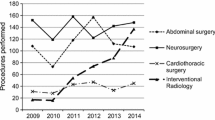Abstract
Purposes
Balancing scheduled surgery and trauma surgery is difficult with a limited number of surgeons. To address the issues and systematize education, we analyzed the current situation and the effectiveness of having a trauma team in the ER of a regional hospital.
Methods
This retrospective study analyzed the demographics, traumatic variables, procedures, postoperative morbidities, and outcomes of 110 patients who underwent trauma surgery between 2012 and 2019. The trauma team was established in 2016 and our university hospital Emergency Room (ER) opened in 2012.
Results
Blunt trauma accounted for 82% of the trauma injuries and 39% of trauma victims were transported from local centers to our institute. The most frequently injured organs were in the digestive tract and about half of the interventions were for hemostatic surgery alone. Concomitant treatments for multiple organ injuries were performed in 31% of the patients. The rates of postoperative severe complications (over Clavien–Dindo IIIb) and mortality were 10% and 13%, respectively. Fourteen (12.7%) of 24 patients who underwent damage-control surgery died, with multiple organ injury being the predominant cause of death.
Conclusion
Systematic education or training of medical students and general surgeons, as well as the co-operation of the team at the regional academic institute, are necessary to overcome the limited human resources and save trauma patients.






Similar content being viewed by others

References
Abe T, Ochiai H. Rapid response doctor cars for cases of severe trauma in remote locations: a life saved owing to cooperation between a doctor car and a physician from a local medical facility. J Rural Med. 2016;11(1):25–9.
Johnsen NV, Betzold RD, Guillamondegui OD, Dennis BM, Stassen NA, Bhullar I, et al. Surgical management of solid organ injuries. Surg Clin North Am. 2017;97(5):1077–85.
Gaarder C, Skaga NO, Eken T, Pillgram-Larsen J, Buanes T, Naess PA. The impact of patient volume on surgical trauma training in a Scandinavian trauma centre. Injury. 2005;36(11):1288–92.
Baker CC, Oppenheimer L, Stephens B, Lewis FR, Trunkey DD. Epidemiology of trauma deaths. Am J Surg. 1980;140(1):144–50.
Esposito TJ, Sanddal ND, Hansen JD, Reynolds S. Analysis of preventable trauma deaths and inappropriate trauma care in a rural state. J Trauma. 1995;39(5):955–62.
Mashiko K. Trauma systems in Japan: history, present status and future perspectives. J Nippon Med Sch. 2005;72(4):194–202 (In Japanese with English abstract)
Yamanouchi S, Sasaki H, Kondo H, Mase T, Otomo Y, Koido Y, et al. Survey of preventable disaster deaths at medical institutions in areas affected by the great East Japan Earthquake: retrospective survey of medical institutions in Miyagi prefecture. Prehosp Disaster Med. 2017;32(5):515–22.
Endo H, Fushimi K, Otomo Y. Volume-outcome relationship in severe operative trauma surgery: a retrospective cohort study using a Japanese nationwide administrative database. Surgery. 2019;166(6):1105–10.
Aoki M, Abe T, Saitoh D, Hagiwara S, Oshima K. Severe trauma patient volume was associated with decreased mortality. Eur J Trauma Emerg Surg. 2020. https://doi.org/10.1007/s00068-020-01352-x(Epub ahead of print).
Nanashima A, Hidaka S, Nonaka T, Yamasaki N, Tsuchiya T, Matsumoto K, et al. Recruitment of young medical apprentices (RYOMA) project: a comprehensive surgical education program at a local academic institute in Japan. J Surg Educ. 2014;71(4):587–92.
Japan Trauma Care and Research of The Japanese Association for the Surgery of Trauma, and The Japanese Association for Acute Medicine. Japan Trauma Data Bank Report 2017 (2012–2016). (http://www.jast-hp.org/trauma/pdf/jtdb2017.pdf)
Fakhry SM, Watts DD, Michetti C, Hunt JP; EAST Multi-Institutional Blunt Hollow Viscous Injury Research Group. The resident experience on trauma: declining surgical opportunities and career incentives? Analysis of data from a large multi-institutional study. J Trauma. 2003;54(1):1–7.
Wada T, Yasunaga H, Doi K, Matsui H, Fushimi K, Kitsuta Y, et al. Impact of hospital volume on mortality in patients with severe torso injury. J Surg Res. 2018;222:1–9.
Reid-Lombardo KM, Glass CC, Marcus SG, Liesinger J, Jones DB; Public Policy and Advocacy Committee of the SSAT. Workforce shortage for general surgeons: results from the Society for Surgery of the Alimentary Track (SSAT) surgeon shortage survey. J Gastrointest Surg. 2014;18(12):2061–73.
Homma H, Oda J, Sano H, Kawai K, Koizumi N, Uramoto H, et al. Advanced cadaver-based educational seminar for trauma surgery using saturated salt solution-embalmed cadavers. Acute Med Surg. 2019;6(2):123–30.
Lefor AK. Trauma surgery simulation education in Japan: the advanced trauma operative management course. Acute Med Surg. 2018;5(4):299–304.
Weber DG, Bendinelli C, Balogh ZJ. Damage control surgery for abdominal emergencies. Br J Surg. 2014;101(1):e109–18.
Furugori S, Kato M, Abe T, Iwashita M, Morimura N. Treating patients in a trauma room equipped with computed tomography and patients’ mortality: a non-controlled comparison study. World J Emerg Surg. 2018;13:16.
Hughes KM, Ewart ZT, Bell TD, Kurek SJ, Swasey KK. Understanding the trauma/acute care surgery workforce. Am Surg. 2019;85(6):638–44.
Acknowledgements
We would like to thank all co-authors and the ER staff from Miyazaki prefecture who supported the operations and data collection in the present study.
Funding
This research did not receive any specific grant from funding agencies in the public, commercial, or nonprofit sectors.
Author information
Authors and Affiliations
Corresponding author
Ethics declarations
Conflict of interest
We have no financial or conflicts of interest to declare.
Ethical approval
The investigations were performed in accordance with the Declaration of Helsinki and the institutional ethical approval was obtained by the University of Miyazaki Faculty of Medicine May 2020 (#O-0698).
Informed consent
Agreement to this retrospective survey and patient’s approval were accepted following the opt-out announcement at the outpatient clinic in our hospital and published on the institutional website of the University of Miyazaki Faculty of Medicine (UoMFM) (http://www.med.miyazaki-u.ac.jp/home/hospital/about/5433/).
Additional information
Publisher's Note
Springer Nature remains neutral with regard to jurisdictional claims in published maps and institutional affiliations.
Rights and permissions
About this article
Cite this article
Kawano, F., Tashiro, K., Ikenoue, M. et al. Current status of trauma surgery at a Japanese prefectural academic institute: improved organization in a regional prefecture. Surg Today 51, 1001–1009 (2021). https://doi.org/10.1007/s00595-020-02196-z
Received:
Accepted:
Published:
Issue Date:
DOI: https://doi.org/10.1007/s00595-020-02196-z



